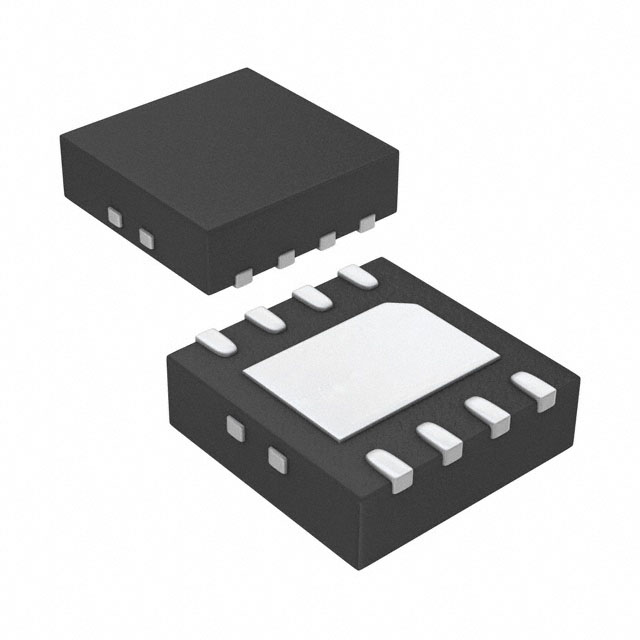LTC2856CDD-1#PBF
Product Overview
Category
The LTC2856CDD-1#PBF belongs to the category of integrated circuits (ICs).
Use
This product is commonly used in various electronic devices and systems for signal transmission and communication purposes.
Characteristics
- The LTC2856CDD-1#PBF is a low-power, half-duplex RS485/RS422 transceiver.
- It operates over a wide voltage range, making it suitable for various applications.
- The device features high data rates and excellent noise immunity.
- It is designed to withstand harsh industrial environments.
Package
The LTC2856CDD-1#PBF comes in a small outline package (SOIC) with 8 pins.
Essence
The essence of this product lies in its ability to provide reliable and efficient communication between different devices or systems.
Packaging/Quantity
The LTC2856CDD-1#PBF is typically packaged in reels or tubes, with a quantity of 250 units per reel/tube.
Specifications
- Supply Voltage Range: 3V to 5.5V
- Data Rate: Up to 20Mbps
- Operating Temperature Range: -40°C to 85°C
- Number of Pins: 8
- Half-Duplex Communication
Detailed Pin Configuration
The LTC2856CDD-1#PBF has the following pin configuration:
- DE (Driver Enable)
- RE (Receiver Enable)
- A (Non-Inverting Data Line)
- B (Inverting Data Line)
- GND (Ground)
- VCC (Supply Voltage)
- RO (Receiver Output)
- DI (Driver Input)
Functional Features
- Half-duplex operation allows bidirectional communication on a single pair of wires.
- Driver and receiver enable pins provide control over the communication direction.
- High data rates enable fast and efficient transmission of information.
- Excellent noise immunity ensures reliable communication in noisy environments.
- Low power consumption makes it suitable for battery-powered devices.
Advantages
- Wide voltage range allows compatibility with various systems.
- Robust design withstands harsh industrial conditions.
- Small package size enables space-saving integration into compact designs.
- High data rates facilitate quick data transfer.
- Low power consumption prolongs battery life in portable applications.
Disadvantages
- Limited to half-duplex communication, which may not be suitable for certain applications requiring simultaneous bidirectional communication.
- The small package size may pose challenges during assembly or repair processes.
Working Principles
The LTC2856CDD-1#PBF operates based on the RS485/RS422 standard. It uses differential signaling to transmit and receive data over long distances. The driver amplifies the transmitted signal, while the receiver detects and decodes incoming signals. The DE and RE pins control the direction of communication, allowing either the driver or receiver to be active at a given time.
Detailed Application Field Plans
The LTC2856CDD-1#PBF finds application in various fields, including:
- Industrial Automation: Used for communication between sensors, actuators, and control systems in factories and manufacturing plants.
- Building Automation: Enables communication between different building management systems, such as HVAC, lighting, and security systems.
- Automotive Electronics: Facilitates communication between different electronic modules within vehicles, such as engine control units, infotainment systems, and sensors.
- Renewable Energy Systems: Allows communication between various components of solar inverters, wind turbines, and energy storage systems.
- Communication Networks: Used in network equipment for reliable data transmission over long distances.
Detailed and Complete Alternative Models
- MAX485EESA+: A similar RS485/RS422 transceiver with a wide supply voltage range and high data rates.
- SN65HVD485E: Half-duplex RS485 transceiver with enhanced ESD protection and low power consumption.
- ADM2485BRWZ: Isolated RS485 transceiver with integrated isolation barrier for enhanced noise immunity.
These alternative models offer similar functionality and can be considered as substitutes for the LTC2856CDD-1#PBF in various applications.
Word count: 610 words
قم بإدراج 10 أسئلة وإجابات شائعة تتعلق بتطبيق LTC2856CDD-1#PBF في الحلول التقنية
Sure! Here are 10 common questions and answers related to the application of LTC2856CDD-1#PBF in technical solutions:
Q1: What is LTC2856CDD-1#PBF? A1: LTC2856CDD-1#PBF is a specific part number for a low-power RS485/RS422 transceiver IC manufactured by Linear Technology (now part of Analog Devices).
Q2: What is the purpose of LTC2856CDD-1#PBF? A2: The purpose of LTC2856CDD-1#PBF is to provide reliable communication over long distances using the RS485/RS422 standard. It can be used in various applications such as industrial automation, building automation, and instrumentation.
Q3: What are the key features of LTC2856CDD-1#PBF? A3: Some key features of LTC2856CDD-1#PBF include low power consumption, high data rates up to 20Mbps, ±60V fault protection, and a wide operating temperature range.
Q4: How do I connect LTC2856CDD-1#PBF to my microcontroller or FPGA? A4: LTC2856CDD-1#PBF uses a standard 3-wire interface (TX, RX, and GND) for communication. You can connect these pins to the corresponding UART or GPIO pins on your microcontroller or FPGA.
Q5: Can LTC2856CDD-1#PBF be used in half-duplex mode? A5: Yes, LTC2856CDD-1#PBF supports both full-duplex and half-duplex communication modes. You can configure it accordingly based on your application requirements.
Q6: How far can LTC2856CDD-1#PBF transmit data? A6: The maximum distance for reliable data transmission depends on various factors such as cable quality, baud rate, and noise levels. However, RS485/RS422 can typically support distances up to 1200 meters.
Q7: Does LTC2856CDD-1#PBF require external components for operation? A7: Yes, LTC2856CDD-1#PBF requires a few external components such as termination resistors, capacitors, and biasing resistors to ensure proper operation. These components are specified in the datasheet.
Q8: Can I use LTC2856CDD-1#PBF in a multi-drop network? A8: Yes, LTC2856CDD-1#PBF can be used in multi-drop networks where multiple transceivers are connected to a single bus. Each transceiver needs to have a unique address or be configured for broadcast communication.
Q9: Is LTC2856CDD-1#PBF compatible with other RS485/RS422 transceivers? A9: Yes, LTC2856CDD-1#PBF is compatible with other standard RS485/RS422 transceivers. It follows the same electrical specifications and communication protocol.
Q10: Where can I find more information about LTC2856CDD-1#PBF? A10: You can find more detailed information about LTC2856CDD-1#PBF in the datasheet provided by Analog Devices. It contains information about pin configurations, electrical characteristics, and application examples.
Please note that the answers provided here are general and may vary depending on specific application requirements. It's always recommended to refer to the datasheet and consult with technical experts for accurate information.


